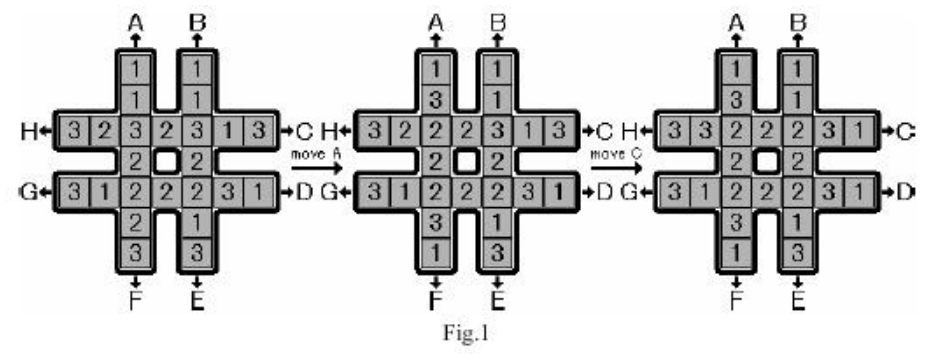原题https://uva.onlinejudge.org/external/13/1343.pdf
题意:
有个#字型的棋盘,2行2列,一共24个格。

如图:每个格子是1或2或3,一共8个1,8个2,8个3.
有A~H一共8种合法操作,比如A代表把A这一列向上移动一个,最上面的格会补到最下面。
求:使中心8个格子数字一致的最少步骤,要输出具体的操作步骤及最终中心区域的数字。如果有多个解,输出字典序最小的操作步骤。
分析:
很明显的一个状态空间搜索问题,不过可以注意到,虽然每一个状态有八个可能的后续状态,随着操作数n的增加,总状态数 8^n 还是大得可怕。比如当n=11时,总状态为8^11 = 85亿。就算通过自己创建特制的哈希表进行状态判重,优化效果并不明显,因为最近一直在做状态空间搜索问题,即使用bfs+剪枝+哈希表,这些程序都无一例外的超时了,所以现在看到状态空间搜索问题,如果没有特别好的剪枝,我绝对不敢用bfs了.....
回到这道题,所有可以用bfs,回溯解决的问题,尤其是解答树的结点数没有明显上限的题,选择用迭代加深搜索算法都特别好用(原因可以参考我上一篇文章)。这里IDA*(迭代加深A*算法)其实说白了就是迭代加深+剪枝.
A*算法是对于每一步考虑 g(n) + h()和MAXD的关系。
稍微解释一下,g(n)是从起点到当前状态的总步数,MAXD是我们提前通过计算证明得到的最短路线总步数的上限,h()是启发函数,是整个算法的关键,我们设计的h()可以预估从当前状态到目标状态至少需要的步数。
这样,上面的关系式就很好理解了。g(n) + h() > MAXD 意味着当前已经走的步数+至少还需要的步数 > 我可以走的步数上限,这种状态,必然已经没有继续的必要,回溯。
对于这道题,可以注意到,对于每一次操作,我们最多可以让中心格子多一个目标数字,如果当前中心格子待整理的数字个数大于我们还可以走的步数,回溯。
这样,就得到了
if (d + num_unordered() > MAXD) return false;
这一核心剪枝公式。 剩下的就简单了。
代码只有52行,还是很简洁的。而且运行速度很快。过30组数据只用了126ms.
1 #include <cstdio> 2 #include <cstring> 3 #include <algorithm> 4 using namespace std; 5 const int MAXN = 24, LEN = 8; 6 int board[LEN][LEN - 1] = { {0, 2, 6, 11, 15, 20, 22}, {1, 3, 8, 12, 17, 21, 23}, 7 {10, 9, 8, 7, 6, 5, 4}, {19, 18, 17, 16, 15, 14, 13}, 8 {23, 21, 17, 12, 8, 3, 1}, {22, 20, 15, 11, 6, 2, 0}, 9 {13, 14, 15, 16, 17, 18, 19}, {4, 5, 6, 7, 8, 9, 10} }; 10 int check_order[] = {6, 7, 8, 11, 12, 15, 16, 17}, a[MAXN], maxd; 11 char order[30]; 12 13 int unordered() { 14 int n1 = 0, n2 = 0, n3 = 0; 15 for (int i = 0; i < LEN; i++) 16 if (a[check_order[i]] == 1) n1++; 17 else if (a[check_order[i]] == 2) n2++; 18 else n3++; 19 return LEN - max(max(n1, n2), n3); 20 } 21 22 void rotate(int di) { 23 int t = a[board[di][0]]; 24 for (int i = 1; i < LEN - 1; i++) a[board[di][i - 1]] = a[board[di][i]]; 25 a[board[di][LEN - 2]] = t; 26 } 27 28 bool dfs(int d) { 29 int cnt = unordered(); 30 if (!cnt) return true; 31 if (cnt + d > maxd) return false; 32 int temp[MAXN]; memcpy(temp, a, sizeof(a)); 33 for (int i = 0; i < LEN; i++) { 34 rotate(i); 35 order[d] = i + 'A'; 36 if (dfs(d + 1)) return true; 37 memcpy(a, temp, sizeof(a)); 38 } 39 return false; 40 } 41 42 int main() { 43 freopen("in", "r", stdin); 44 while (scanf("%d", &a[0]) && a[0]) { 45 for (int i = 1; i < MAXN; i++) scanf("%d", &a[i]); 46 if (!unordered()) { printf("No moves needed %d ", a[6]); continue;} 47 for (maxd = 1;; maxd++) if (dfs(0)) break; 48 for (int i = 0; i < maxd; i++) printf("%c", order[i]); 49 printf(" %d ", a[6]); 50 } 51 return 0; 52 }

顺便纪念一下排第六(前面3个是virtual oj......)